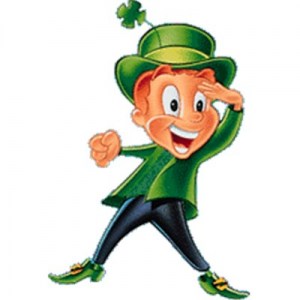The image to the left is an artist’s rendering of what Saint Patrick may have looked like.
At least that’s what it would seem many people today think. Like any good capitalist society, America has reduced St. Patrick’s Day to it’s most commercially friendly form. Not unlike Christmas, the actual meaning of the holiday is long lost. Similar to Cinco de Mayo, Saint Patty’s Day is a celebration of some of the things a particular culture has to offer. Like Valentine’s Day, the holiday was originally intended to honor a saint most of us know nothing about.
Believe it or not, St. Patrick’s Day is not just about corned beef, cabbage, leprechauns, four-leaf clovers, and pinching people who forget to wear green (Not that these things aren’t great. In fact, if you plan on preparing your own St. Patrick’s Day feast, I recommend buying the corned beef now. From experience I can tell you that grocery stores will sell out if you wait too long. You’re welcome.). What is about to follow is a brief summary of who everyone’s favorite Irish saint was and how we came to celebrate him every March 17th.
Patrick was born in the mid-to-late-fourth century (exact date unknown) in Britain to Christian parents. At the age of 16 he was kidnapped from his father’s home by Irish raiders and brought into slavery in Ireland. He was held captive there for more than six years. Then one day he had a dreamed in which he believed he heard God speaking, telling him to leave Ireland. So he did. It is believed he walked nearly 200 miles from where he was being held at the time to the Irish coast where he boarded a ship back to Britain.
Some time later, as he recounts in his autobiography, Confessio, he had another dream in which a man named Victoricus handed him a letter entitled, “The Voice of the Irish.” As he began to read it he imagined the voices of the Irish people calling to him to “come and walk among us.” He believed this to be a calling to become a missionary to Ireland. However, due to his lack of education, he was hesitant to respond to the call so he began religious training which lasted more than 15 years. After his ordination, he set off back to Ireland to minister to the Christians there and to convert the predominantly pagan population to Christianity. After roughly 30 years in this mission, he died.
This basically concludes what we know about Saint Patrick with any type of certainty. The rest is part conjecture and part legend. For instance, Patrick is credited with creating the Celtic cross. The story goes that the symbol of the sun was very important to the pagans in Ireland. As he was going about his mission of introducing them to Christianity, he superimposed a sun on the cross in order to make it more culturally significant, giving us what we now know as the Celtic cross. It is also believed that he used the three-leafed shamrock, Ireland’s national flower, to explain the doctrine of the trinity. Also notable is the legend that Patrick banished snakes from the country. Apparently no snakes exist on the island (I was unaware of this. If we have any Irish readers, feel free to correct me.), and this is said to be due to Patrick chasing them into the sea after they attacked him during a 40-day fast. (If there’s anyway we can incorporate this into our annual St. Patrick’s Day celebration count me in.)
Today we celebrate the patron saint of Ireland on March 17. Though the year of his death, like his birth, is disputed, this is believed to be the day he died. In predominantly Irish Catholic communities, the day is observed as a religious holiday. Saint Patrick’s Day is a public holiday in the Republic of Ireland and Northern Ireland. Though falling in the middle of Lent, prohibitions against the consumption of meat are suspended and feasts are enjoyed. Saint Patrick’s Day is also to be a day to remember and pray for missionaries.
Today, few people know why we celebrate St. Patrick’s Day. Hopefully this wee bit of background information will make the celebration a little more meaningful. Let’s remember the missions work of Saint Patrick and pray for our missionaries of today. And don’t forget to wear green.




Leave a Reply
Your email is safe with us.